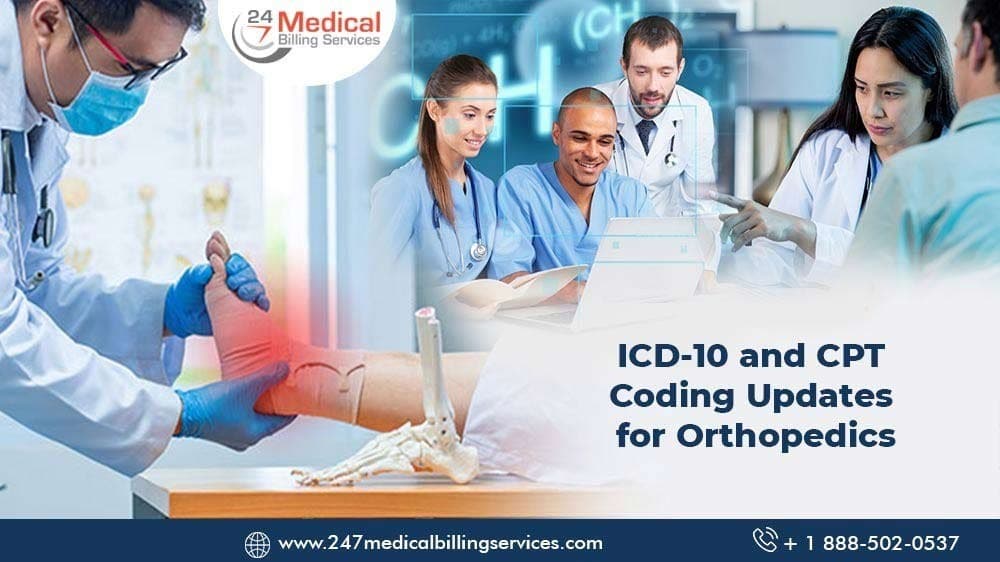
ICD-10 and CPT Coding Updates for Orthopedics
To avoid denials, orthopedic practices (like all specialties) must stay up to date on the latest coding updates and rules. One deleted code and several new musculoskeletal CPT codes have been added to chiropractic and orthopedic medical billing with effect from January 1, 2020. Let's look at the most important musculoskeletal CPT coding updates for orthopedics, physicians, physical therapists, and other qualified health care providers (QHPs):
- 2 Codes for Dry Needling
Several filiform needles are inserted into "trigger points" in the muscle or tissue during dry needling. This technique, also known as intramuscular stimulation or "trigger point acupuncture," involves no fluid injection. Dry needling relaxes knotted, or hard muscles, improves microcirculation, eliminates neurotoxins, and relieves pain or spasms. The practitioner will determine how long the needles must remain in the skin. There will be two new CPT Coding Updates for Orthopedics for needle insertions without injections:
- 20560: Insertion(s) of a needle without injection (s) of one or two muscles
- 20561: Three or more muscles
- 6 Drug Delivery Device Implantation Add-on Codes
Implantable drug delivery systems allow for consistent, predetermined drug delivery. They enable optimal dosing during treatment, reducing potential side effects and increasing the efficacy of treatment. Implantable drug delivery devices are widely utilized in diseases requiring long-term therapy or patient compliance issues, such as tuberculosis, cardiovascular disease, cancer, diabetes, and chronic pain management.
Drug-releasing implants in orthopedic surgery allow local drug delivery to the bone to treat the infection. These implants are available in various sizes, ranging from a tiny "antibiotic bead" to an antibiotic-loaded cement knee prosthesis spacer. Biodegradable or non-biodegradable drug delivery implants are available. Non-biodegradable antibiotic implants that were implanted during surgery to relieve post-operative pain will be removed in the office as part of the post-operative care services.
There are six new add-on codes for insertion, manual preparation, and removal of implants for drug delivery to deep musculoskeletal spaces:
- 20700: Manual preparation and insertion of a deep drug-delivery device(s) (example: subfascial)
- 20702: Manual preparation and insertion of an intramedullary drug-delivery device(s)
- 20704: Manual preparation and insertion of an intra-articular drug-delivery device(s)
- 20701: Removal of a deep drug-delivery device(s)
- 20703: Removal of an intramedullary drug-delivery device(s)
- 20705: Removal of an intra-articular drug-delivery device(s)
Points to consider when coding drug delivery implantations
- One must always report these add-on codes in conjunction with other procedures. The parenthetical notes indicate the primary codes with which the add-on codes can be reported.
- The new area inserted add-on codes can only be reported once per anatomic location.
- The new drug delivery codes require the physician or QHP to manually mix and prepare antibiotics with a carrier substance during the surgical procedure. The provider then applies the mixture to the delivery device, such as nails, beads, or spacers.
- Premixed or boxed drug delivery implants already have the drug-infused into them. This means that no manual mixing by the doctor is required. The CPT Coding Updates for Orthopedics for reporting premixed drug delivery implants are as follows:
- 11981: Insertion, Non-biodegradable drug delivery implant
- 11982: Removal, Non-biodegradable drug delivery implant
- 11983: Removal and reinsertion, Non-biodegradable drug delivery implant
- Orthopedic medical coders must be able to correctly assign drug delivery implant codes and identify the type of drug delivery system from clinical documentation. For example, a Health Information Associates (HIA) article warns coders not to confuse articulating spacers with drug delivery systems. Articulating spacers are revision implants that should be reported via CPT code 27487.
- 2 New Category III Codes for Knee Autologous Cellular Implant
The AMA CPT Manual adds two new Category III codes for implants made from adipose tissue and injected into the knee to treat osteoarthritis:
- 0565T: Adipose-derived autologous cellular implant for the treatment of knee osteoarthritis; tissue harvesting and cellular implant creation
- 0566T: Adipose-derived autologous cellular implant for the treatment of knee osteoarthritis; injection of the cellular implant into the knee joint with ultrasound guidance, unilateral
- 2 Category III Codes for Musculoskeletal Diagnostic Procedures
Two new Category III codes for musculoskeletal diagnostic procedures have been added: bone strength and fracture risk assessments and touch bone biopsy:
Assessments of bone strength and fracture risk
- 0554T: Bone strength with fracture risk using finite element (FE)
- Functional data analysis and bone-mineral density using data from a computed tomography (CT) scan; retrieval and transmission of scan data, assessment of bone strength and fracture risk, interpretation, and report
- 0555T: Scan data retrieval and transmission
- 0556T: Evaluation of bone strength, fracture risk, and bone mineral density
- 0557T: Interpretation and report
Revenue Cycle Advisor provides the following essential information about these new codes:
- 0554T: Describes all components of a FE and CT analysis used to measure bone strength and density
Acquisition (by the physician) of bone mass measurements and data on bone-mineral density from previously obtained CT scans, assessment of bone strength, fracture risk, and density, and a written report.
- 0555T-0557T: Describes individual elements of the fracture and bone strength risk analysis
Orthopedic coders should report as many of these codes as are required to describe the performed service.
- Codes 0555T-0557T should not be reported in conjunction with code 0554T.
Touch bone biopsy
- 0547T: Bone material quality testing via tibial micro-indentation(s), with results reported as a score.
Why Not Outsource Orthopedic Medical Billing and Coding?
An hour is needed to outsource the orthopedic medical billing and coding to experts such as 24/7 Medical Billing Services. The team at this outsourced medical billing partner stays current on orthopedic coding changes. In fact, experts in orthopedic medical billing and coding examine the physician's documentation to make sure that it clearly specifies the nature of the procedure performed. This will allow for proper billing and reporting, avoiding denials, and ensuring maximum reimbursement for services rendered.
Read more: How To Bill Correctly For Your Orthopedic Practice?

.png)